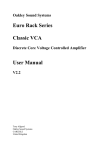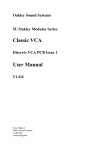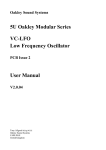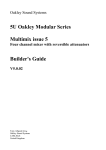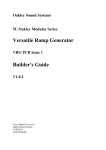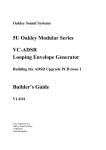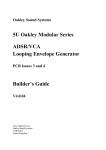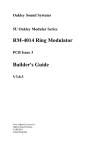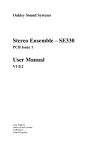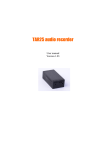Download Human Voice Module User Manual
Transcript
Oakley Sound Systems Human Voice Module PCB Issue 1 User Manual V1.0.1 Tony Allgood Oakley Sound Systems CARLISLE United Kingdom Introduction This is the User Manual for the issue 1 Human Voice Module (HVM) from Oakley Sound. This document contains an overview of the unit and goes into some detail regarding the operation of the module. For the Builder's Guide, which contains a basic introduction to the circuit board, a full parts list for the components needed to populate the board or boards, and a list of the various interconnections, please visit the main project webpage at: http://www.oakleysound.com/hvm.htm For general information regarding where to get parts and suggested part numbers please see our useful Parts Guide at the project webpage or http://www.oakleysound.com/parts.pdf. For general information on how to build our modules, including circuit board population, mounting front panel components and making up board interconnects please see our generic Construction Guide at the project webpage or http://www.oakleysound.com/construct.pdf. 2 The Oakley Sound Human Voice Module The Oakley Sound HVM is an electronic audio signal modification device that attempts to replicate some of the sounds from two classic keyboards first seen and heard in 1979. The module consists of three sections, two band pass filter networks and one parametric equaliser. It is possible to use each section independently if built that way but the suggested panel design has them wired together so as to allow maximum flexibility with the smallest number of front panel controls. The design the bandpass filter network takes its inspiration from the beautiful haunting sounds of the Lambda's chorus ensemble and the VP-330's human voice presets. In the suggested panel design of the HVM these are labelled Chorus and Vox respectively. A simple toggle switch on the panel allows the user to switch between the two modes. The chosen output then goes to a wet/dry mixer control pot. This sets the mix between the untreated audio input and the affected sound. The output of this control is then fed to a parametric equaliser circuit that can boost (+20dB) or cut (-20dB) a selected frequency band between 50Hz and 11kHz. Bandwidth, Q, can be controlled with the emphasis pot and can be varied from around 1 to 25. Input and output level control pots are also provided to allow maximum flexibility in dealing with a variety of input signal levels. Both the input and output connections are balanced but can be used with unbalanced connections if desired. 3 Operating Instructions INPUT LEVEL The unit features a balanced input pre-amplifier. The word amplifier implies that it increases the signal level. In this case it does not. The HVM's input circuitry does not apply any gain at all. With the input level and output level controls set to their maximum and the mix pot set to 'dry' the HVM will not significantly change the volume of the input signal. However, the HVM contains three audio processors and all three can change the volume of the sound dramatically. So to ensure that no stage produces unwanted clipping the input level, and output level, controls should be set accordingly. The HVM features no clipping indicator LEDs so you must use your ears to decide the best level. The unit may be driven deliberately into distortion if this is what you desire. Rest assured this will do no harm to the HVM, although your ears may be less forgiving. MODE The HVM has two filter networks. The first, CHORUS, replicates the actions of the Lambda's chorus preset. The Lambda featured three sets of divide down oscillator ranks, each slightly detuned from one another. This created a rich sound which was then filtered by different circuitry for each of the unit's presets to give the specific sound required. To get the HVM to replicate the exact sound of the Lambda would require the same input source but it can replicated closely enough by feeding the HVM with a single sawtooth signal and using a digital or analogue ensemble unit to process the HVM's output. The second of the HVM's filter networks is vastly more complex inside. The VOX mode utilises the same circuitry as found in the VP-330's human voice filters. This filter consists of seven individually tuned band pass filters. Not all the filters are actually heard at once, the specific ones being selected by the pitch and footage switches on the HVM. The pitch and footage switches have no affect when the HVM is in chorus mode. The mode switch selects whether the input signal will be processed by Lambda's filter network or the VP-330's network. The chosen output is then sent to the MIX control. It is not possible to hear both filters at the same time. PITCH The VP-330 has a four octave keyboard which can be split so that the upper section can sound different to the lower section. The filtering for the human voice preset is slightly different for 4 the upper and lower sections to make the overall sound more realistic when notes are played over the whole keyboard. The HVM is not able to split the incoming signal into upper and lower since it does not know what sort of signals are to be processed. The PITCH switch thus allows the user to manually select which frequency range you will be sending to the unit. In practical use the PITCH switch can simply be used to alter the timbre of the output signal. FOOTAGE On the VP-330 there are two switches, called tabs, on each of the upper and lower sections. The tabs direct the VP-330's oscillator rank to the filter networks with each switch sending different proportions of the signal to each filter. The VP-330 is based on organ technology so it uses the nomenclature of 4” and 8” to describe the pitch of the oscillator rank. 4” being an octave above 8” - think of organ pipe lengths. The HVM has no oscillator ranks so relies on the user to determine which set of filters to enable. Again, like the PITCH switch, you simply use the one you like the sound of. However, the 4” setting will sound more authentic if you use higher notes than you would with the 8” setting. With the 4” setting and the upper mode selected the sound heard will be more akin to a female voice. MIX This adjusts the mix between the unaffected signal and the one coming from the selected filter network. DRY is the unaffected signal while WET is the fully filtered signal. The volume level between wet and dry may well appear to be different as the filter networks have a profound affect on the volume of certain frequencies. However, be aware that the highly selective nature of both the vox and chorus filter networks will mean that some, notably the higher, frequencies will greatly exceed the level of the input. EQ GAIN EQ in the HVM is short for parametric equaliser. The type of equaliser included in the HVM is called a peak type because it boosts and cuts around a chosen frequency selected by the EQ FREQUENCY pot. The GAIN pot controls the amplification of the frequency band. With the gain pot in the middle, straight up, the equaliser has little affect on the signal. Fully clockwise the maximum gain is +20dB, while fully anticlockwise the minimum gain is -20dB. -20dB being a cut in signal level of 20dB. These are both pretty extreme changes in signal level and at high gain it is very easy to overload the circuitry and produce unwanted distortion. Carefully adjusting the input and output levels can prevent this type of distortion. EQ FREQUENCY This pot selects the centre frequency of the band of frequencies that will be cut or boosted. The range of this control goes from around 50Hz to 11kHz. Rapidly moving this control from a high to a low value will cause a slight audible 'thump' from the output. EQ EMPHASIS This pot selects the bandwidth of the equaliser. The bandwidth is essentially the range around the centre frequency that will be boosted or cut. With the pot fully clockwise the range is very 5 small. We say the filter has a high Q or high selectivity. At the other end the Q will very low and the band of affected frequencies very wide. With low values of Q the effective volume of the signal will be affected more since a greater range of frequencies are under the control of the gain pot. Not all parametric equalisers work this way so the HVM may behave differently to other EQs you have used. POWER LED This will light when power is applied to the unit. To be precise, it lights when the positive power supply rail is up and running. If AC power is applied, the unit switches on and this light is off then your unit has a problem. OUTPUT LEVEL This adjusts the output level of the unit. If your unit sounds distorted you should try turning down this control first. If that fails adjust the input level control accordingly and bring the output level up to compensate. Input and Output Connections The HVM has both balanced input and output connections. It is expected that the unit will be fitted with three pole TRS (tip-ring-sleeve) sockets. Both input and output are compatible with unbalanced signals and mono jack plugs can be used without detriment to the HVM. It should work fine with signal levels direct from a mixer, line level synthesisers and modular synthesisers. The input impedance is too low to work direct from guitars unless they are fitted with internal pre-amplifiers. The maximum input signal level that can be tolerated is +/-12V if the HVM has a +/-15V internal supply. Signal levels higher than +/-30V have the potential to damage the unit. Input impedance is 44K. Output impedance is 220R. 6 Final Comments I hope you enjoy using the Oakley Sound HVM If you have any problems with the module, an excellent source of support is the Oakley Sound Forum at Muffwiggler.com. If you have a comment about this user manual, or have a found a mistake in it, then please do let me know either via e-mail or the forum. Tony Allgood at Oakley Sound Cumbria, UK © March 2013 No part of this document may be copied by whatever means without my permission. 7







